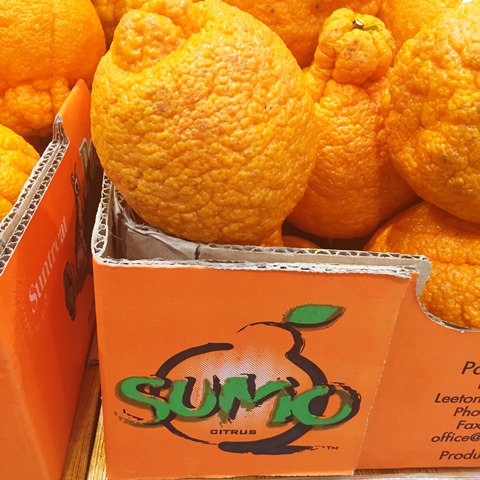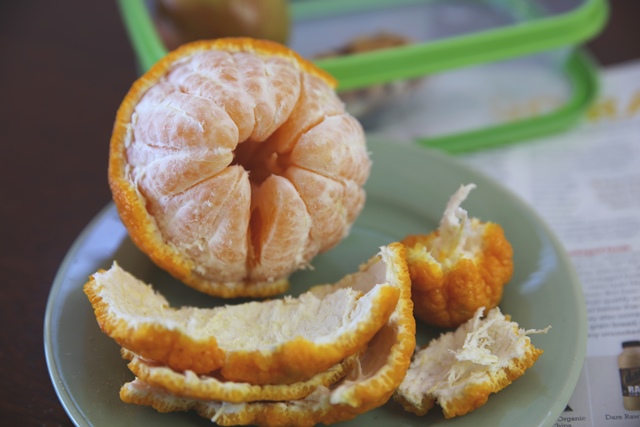Sumo citrus – don’t judge this fruit by its ‘cover’!
Written by Guest post
on Wednesday, 26 August 2015.
Tagged: convenience, fibre, fresh food, healthy eating, review

Sumo citrus might just be the ugliest citrus you’ve ever seen but on the inside these mandarin-orange hybrids are anything but! They are large, seedless and easy to peel. I’m really enjoying them as a convenient between-meal snack. They’re new to the Australian market, but have been grown in Japan for over forty years. Find out exactly what makes this, now locally grown, fruit so special…
What’s big, orange and ugly?
If you’ve popped into your local Woolworths supermarket in recent weeks, you might have noticed the new citrus fruit on offer this winter. Grown in Australia’s Riverland, Riverina and Sunraysia regions (in South Australia and Victoria, respectively), Sumo citrus are a locally grown version of this Japanese fruit.
They’re a mandarin-orange hybrid with rough, bumpy skin and a distinctive top knob. And just like their namesake, these Sumo’s are big (my two Sumos weighed 800 g)! They’re closer in size to an orange, but with a thick, easy-to-peel skin and large segments much more like a mandarin. With their pointy nipple-end, they reminded me of the older tangelo which was a cross between a grapefruit and a mandarin. However, these Sumo are less messy and nicer to eat. A win-win!

The Sumo citrus website states they have ‘a look that only a grower could love’, and boy were they right. You could be forgiven for thinking these were a new addition to The Odd Bunch (Woolworth’s take on the ugly fruit and veg campaign). These misshapen fruit are anything but uniform but what they lack in looks, they make up for in taste.
How Sumos stack up against other citrus
 We taste-tested these Sumos and found that beneath a rough exterior, the seedless segments were sweeter than an orange (thanks to their low acidity level) and juicy.
We taste-tested these Sumos and found that beneath a rough exterior, the seedless segments were sweeter than an orange (thanks to their low acidity level) and juicy.
To peel you simply twist the top knob off, leaving you with an nice hole to start peeling from. They’re less messy, as their pithy membranes seem to stick to the inside of the peel rather than the fruit. And being seedless means there’s no awkward spitting after each bite!
Like any citrus, these are a good source of vitamin C, potassium, folate and fibre. They’re filling, while also quenching your thirst and hitting that sweet spot. They’re great fresh as a snack, but the segments could also be used in salads, or the juice and zest in cakes and other baked goods.

At $6.98 per kilogram, they are more expensive than other citrus (e.g.Imperial mandarins, cost $4.98 per kilogram, 30 per cent cheaper.) – my two Sumo cost $2.79 each! And they’re bulky, so you’ll need plenty of room in your lunch box to be able to fit one in!
The verdict
They may be a bit more expensive than other citrus, but we think these Sumo-sized, Australian-grown fruit are worth it. Sweet, juicy and seedless, with a fun-to-peel top knob, they make a great snack. So why not give them a try? But hurry, they only have a limited season, available from August to September exclusively in Woolworths.
Guest post by Megan Cameron-Lee (BND), APD
Blog: http://thedieteticdegustation.blogspot.com.au
Main photo courtesy of Dianne McMillan from Flickr
You may also be interested in...
Like to have your product reviewed by Catherine?
 This post was researched and written by Catherine Saxelby, an accredited nutritionist, dietitian, author and award-winning food communicator. Catherine's goal is to help busy working women eat well, maintain a healthy weight and boost their energy.
This post was researched and written by Catherine Saxelby, an accredited nutritionist, dietitian, author and award-winning food communicator. Catherine's goal is to help busy working women eat well, maintain a healthy weight and boost their energy.
Checkout Catherine’s other posts, books and product reviews or sign up for her free Foodwatch newsletter. To have your product or service reviewed by Catherine and her team, click here.
Sign up for Catherine's free Foodwatch newsletter
About the Author
Catherine Saxelby has the answers! She is an accredited nutritionist, blogger and award-winning author. Her award-winning book My Nutritionary will help you cut through the jargon. Do you know your MCTs from your LCTs? How about sterols from stanols? What’s the difference between glucose and dextrose? Or probiotics and prebiotics? What additive is number 330? How safe is acesulfame K? If you find yourself confused by food labels, grab your copy of Catherine Saxelby’s comprehensive guide My Nutritionary NOW!
The Good Stuff
The Boring Stuff
© 2023 Foodwatch Australia. All rights reserved
Author photo by Kate Williams
Website by Joomstore eCommerce









